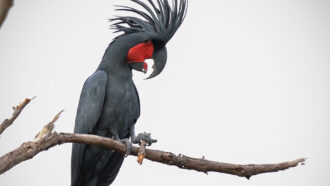All Stories
-
 Humans
HumansSenses help the brain interpret our world — and our own bodies
Most people are familiar with sight, hearing, smell, taste and touch –– but there are others. Learn about them here.
-
 Tech
TechHow to prevent the robot replication apocalypse
Today’s bot-building robots aren’t set on world domination. But scientists and philosophers want to keep future tech in check.
By Skyler Ware -
 Physics
PhysicsExperiment: How well do different materials create static electricity?
Why are some materials more susceptible to static cling than others? Investigate by making your own electroscope.
-
 Animals
AnimalsSome cockatoos craft drumsticks, then woo mates like a rockstar
To win over a gal, these flashy males craft and use their signature instruments in a musical display akin to a human rock concert.
By Elise Cutts -
 Humans
HumansScientists Say: Prehistoric
Researchers rely on prehistoric tools and other artifacts to study the vast stretches of time before recorded history.
-
 Oceans
OceansExplainer: Why are so many hurricanes strengthening really fast?
This dangerous trend appears relatively new — and growing. Studies also have begun linking it to our warming world.
-
 Climate
ClimateHydrogen energy could help our climate — depending on its source
Hydrogen energy doesn’t emit greenhouse gases when it’s used. But how it’s produced will affect how useful it can be in slowing climate change.
-
 Tech
TechExplainer: The hydrogen rainbow
Hydrogen works the same, regardless of its source. But how clean or “green” it is very much hinges on its color-coded name — which points to how it was made.
-
 Space
SpaceYou can get involved in science during the 2024 solar eclipse
The sun will be near the peak of its activity cycle during the eclipse on April 8, 2024. That will make it a great time to crowdsource solar research.
-
 Brain
BrainLet’s learn about mind reading
In the future, more advanced, less bulky mind-reading equipment could raise serious privacy concerns.
-
 Physics
PhysicsScientists Say: Gamma ray
Lightning bolts, nuclear explosions, colliding stars and black holes all throw off this high-energy type of light.
-
 Tech
TechEngineers cook up a new way to tackle CO2: Make baking soda
Engineers have found a material that can collect carbon dioxide from the air. When later mixed with water, it forms baking soda that can be shed in the sea.